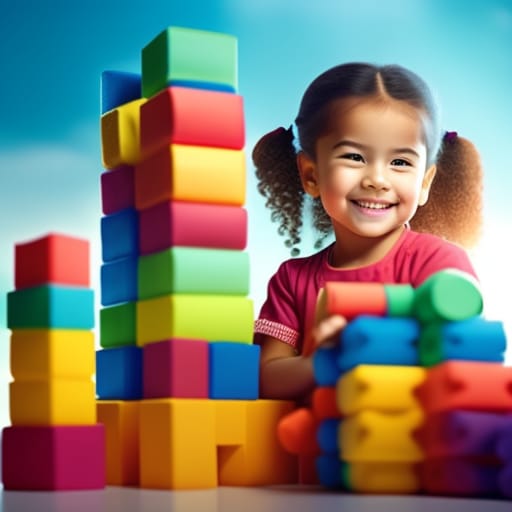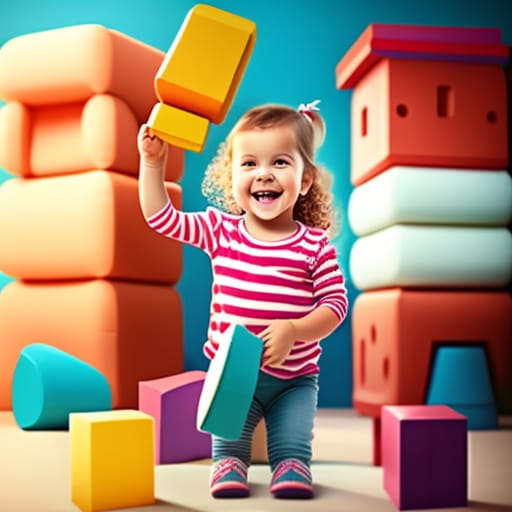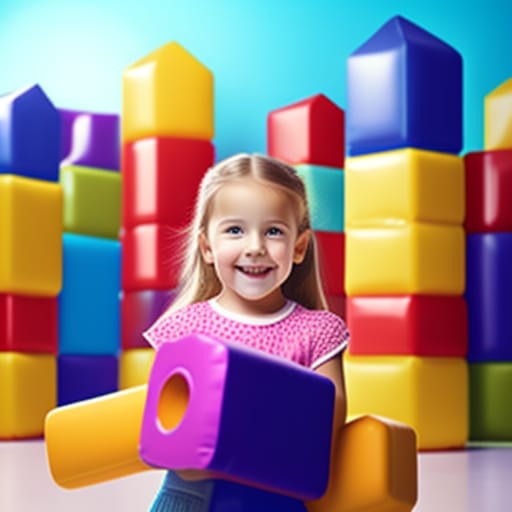Playing with blocks is a timeless childhood activity that offers a world of fun and learning for kids of all ages. As a parent, you want to provide your child with the best blocks to stimulate their creativity and support their development. This beginner’s guide will explore the wonderful world of play blocks, the benefits they offer, and things to consider when choosing blocks for your child.

What Are Play Blocks?
Play blocks are construction toys made up of various shapes, sizes, colors and materials that allow children to stack, arrange, and build structures and designs. One of the most classic block types is wooden unit blocks. These simple wooden cubes, rectangles, arches and triangle blocks allow open-ended building play.
Other common block varieties include:
- Plastic blocks – Offer bright colors, lightweight, and versatility. Lego blocks are a famous example.
- Magnetic blocks – Allow structures to be built vertically with magnetic connections.
- Foam blocks – Soft and light, ideal for infants and toddlers.
- Cardboard blocks – Affordable option that is lightweight.
- Electronic blocks – Incorporate lights, sounds, and technology into block play.
No matter what type of blocks you choose, block play encourages the following skills in children:
- Spatial reasoning
- Math skills like shape recognition, counting, measuring
- Motor skills
- Creativity and imagination
- Problem-solving
- Early physics concepts like balance and stability
- Collaboration when playing with others
- Language development
With so many benefits, blocks are a toy with longevity that will grow with your child through different developmental stages.
Benefits of Playing With Blocks
Playing with blocks offers a multitude of benefits that boost your child’s overall learning and development.
Spatial Reasoning
Stacking blocks requires children to analyze shapes and sizes, develop spatial reasoning, and understand balance. Recognizing how blocks fit together in three dimensions helps improve spatial visualization, geometry skills, and hand-eye coordination.
Math Skills
Counting blocks, noticing patterns, categorizing by shape or color, and creating symmetrical structures are all great ways to develop early math concepts. Comparing lengths and heights builds foundations for more complex math down the road.
Motor Skills
Grasping, picking up, stacking, and maneuvering blocks promotes fine motor dexterity. Building large structures challenges gross motor skills. This hands-on learning is very beneficial for improving hand-eye coordination.
Creativity and Imagination
The possibilities are endless when building with blocks! Structures and scenes are only limited by your child’s imagination. Open-ended block play allows creative thinking, storytelling, and inventiveness to flourish.
Problem Solving
To build elaborate structures, children must creatively problem-solve ways to balance, connect, and support different blocks. Trial and error teaches persistence and critical thinking.
Early Physics
Children can learn foundational physics concepts like gravity, balance, stability, and force through interactive block play experiences. Seeing how structures topple and how height impacts stability introduces scientific principles.
Social Skills
Collaborative building promotes compromise, cooperation, and communication. Block play with peers encourages sharing ideas, teamwork, and language development.
With such a wide range of developmental benefits, blocks are truly an educational toy with immense learning potential.
Factors to Consider When Choosing Blocks
All blocks offer intellectual benefits for kids, but you’ll want to choose the blocks that best match your child’s interests and stage of development. Here are some factors to consider:
Age of Child
- Infants – Lightweight, soft blocks with simple patterns are best for small hands. Avoid small parts.
- Toddlers – Look for blocks in creative shapes and colors to stimulate imaginations. Large pieces are ideal for unsteady hands.
- Preschoolers – Introduce more complex block sets to challenge budding skills. Add accessories like people and animals.
- School-age – Engage older kids with specialized blocks like Lego, erector sets, or robotics kits.
Types of Blocks
Factor in your child’s preferences, play space and needs:
- Classic wooden unit blocks are lovely open-ended toys to spur creativity.
- Interlocking blocks add more building challenges.
- Jumbo blocks are great for easy grasping by little hands.
- Soft blocks are perfect for infants and toddlers who may throw or mouth them.
- Glow-in-the-dark or light-up blocks add science appeal.
- Licensing themes, like Disney characters, appeal to many kids.
Safety
- For babies and toddlers, avoid blocks with detachable small parts which could present a choking hazard.
- Look for BPA-free blocks made from non-toxic materials.
- Avoid pointed, sharp corners or edges.
- Don’t overlook weight – very heavy blocks could tip over and hurt small children.
Budget
Kid’s blocks range widely in price from $10 basic sets to $100+ large collections. Consider how often your child will use blocks, and invest accordingly in quality sets that will last over time. Opt for wooden or plastic blocks rather than foam or cardboard for durability.
Storage
Look for bins, organizers, or shelving to neatly store blocks when not in use. Proper storage will make cleanup easier and extend the lifespan of your blocks.
By carefully evaluating your child’s age, interests, abilities, and environment, you can select the ideal block set to delight and educate.

Top Block Sets for Kids of All Ages
Here are some of the best-rated and most popular block sets to consider:
For infants and toddlers:
- Hape Shape Sorter Wooden Toy
- Features chunky, colorful wood shapes
- Helps develop hand-eye coordination and shape recognition
- Non-toxic water-based paint
- Melissa & Doug Stacking Blocks
- 30 soft, lightweight plastic blocks
- Vibrant colors and cute smiley faces
- Promotes fine motor skills
- Green Toys Stacker
- Made of safe, recycled plastic
- Easy-to-grasp stackable rings
- Improves dexterity and gross motor skills
For preschoolers:
- Lovevery Block Set
- High-quality maple wood construction
- Developed with child development experts
- Promotes imaginative play, counting, and sorting skills
- Magna-Tiles Clear Colors 100 Piece Set
- Translucent, magnetic plastic pieces
- Allows creativity and design thinking
- Great STEM building toy
- Melissa & Doug Unit Blocks
- Natural unfinished wood look
- Open-ended building toy
- Improves spatial reasoning skills
For school-age kids:
- K’NEX Educational Building Set
- Over 300 plastic building pieces
- Build rollercoasters and Ferris wheels
- Fosters STEM learning
- LEGO Classic Creative Brick Box
- 484 versatile LEGO bricks
- Sort and store in a durable plastic box
- Encourages creative building
- Roominate Deluxe Kit
- 152 pieces including motor and fan
- Build circuits for lights and motion
- Girls designing dollhouses, cars, and more
Choosing the right blocks for your child’s interests and abilities allows them to fully experience the many developmental benefits of block play. Buying quality block sets from reputable brands ensures engaging and educational play for years to come.

Making the Most of Block Play
To fully reap the learning potential of blocks, engage your child during play and create an enriching environment. Here are some tips:
- Play with your child sometimes, following their lead. Describe what they are doing and add vocabulary.
- Occasionally, give gentle challenges like “What if we build a garage for these cars?”
- Ask open-ended questions to develop problem-solving and reasoning skills.
- Provide accessories like toy people, animals, signs, cars, etc. to boost imaginative play. Rotate accessories to maintain novelty.
- Designate an inviting block play space with room to spread out and easy storage access.
- Add variety to block structures by incorporating blocks of different sizes, shapes, and textures.
- Take photos of impressive block creations to save memories of their building accomplishments.
- Limit screen time and make blocks easily available to encourage hands-on play.
Giving your child unstructured time to freely build with blocks allows their natural creativity, curiosity, and skills to emerge. Resist the urge to direct their play; instead, be an engaged facilitator. With your support, block play can become a beloved childhood activity packed with learning.
Frequently Asked Questions About Play Blocks
Are wooden or plastic blocks better?
Both offer benefits! Wooden blocks feel natural and warm. Plastic blocks allow bright colors, unusual shapes, and more versatility. Mix materials for sensory variety.
What’s the best starter block set for a 1-year-old?
Look for around 25-30 large, chunky blocks in simple shapes and colors. Soft blocks are ideal for little hands. Avoid small parts.
How do I clean dirty blocks?
Use mild soap and warm water, and rinse thoroughly. Disinfect with diluted bleach solution if needed. Air dry completely before storage.
How can I get more educational value from blocks?
Add props for storytelling, introduce math with counting games, build vocab by describing structures, and conduct block experiments like testing strength.
Should I assign structured block activities?
Most experts recommend unstructured block play, but occasionally providing challenges can stretch abilities. Mix child-led exploration with guided activities.
The Benefits of Block Play Last a Lifetime
Playing with blocks is such a classic, beloved childhood activity that offers immense benefits for development and learning. With an understanding of the many skills blocks build, you can make an informed choice selecting block sets tailored for your child’s age and interests. Blocks inspire imagination, problem-solving, creativity, and so much more. By providing an enriching block play environment, you encourage your child’s natural development while having fun. Blocks truly are the building blocks for a lifetime of learning.